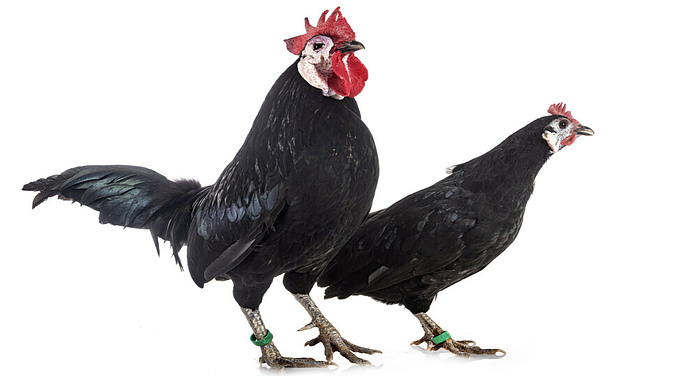
| Breed Name | Dual Purpose | Hardiness | Egg Size/Color/Amount | Feather Color | Status | Compatibility with Other Breeds |
|---|---|---|---|---|---|---|
| White-faced Black Spanish | Low/Moderate | Black w/Green Tint | Critical |
I’m fascinated by the various breeds of poultry gracing our farms and backyards, and today, I’m sharing insights on one particularly impressive breed – the Spanish chicken. Renowned for its striking appearance and distinctive attributes, this breed captures the attention of anyone who gets the chance to see it.
Standout features of Spanish chickens include their glossy black plumage, which can shimmer with iridescent green in sunlight, and their large, stark white earlobes that contrast sharply with their dark feathers.
These prominent earlobes aren’t just for show; they’re an indicator of the breed’s excellent egg-laying capabilities.
Furthermore, their intelligent and active nature often turns the common task of egg collection into an engaging daily pursuit.
But their beauty and smarts only scratch the surface. To truly appreciate Spanish chickens, one must look into their history, understand their versatility as a breed, and learn about their care requirements – Spoiler… they are needy.
As we explore these facets, you’ll discover why Spanish chickens could be a challenging addition to your flock.
The Origin of Spanish Chickens
Spanish chickens can trace their possible origins back to Holland or the Iberian Peninsula. It’s unclear.
Known historically for their distinct appearance, these birds were valued for their aesthetic appeal and also for egg-laying ability.
These elegant birds have a story that begins centuries ago. The exact timeline can be hazy, but it’s clear that they hold a place in Spanish agriculture.
Over time, and with careful selection, the modern Spanish chicken emerged as a breed with its unique traits solidified.
The history of Spanish chickens isn’t just about the birds themselves. It’s a reflection of the cultures and people who raised them.
The breed stands today as a testament to the art of breeding and past generations’ value of meticulous selection for desirable characteristics.
However, this meticulous breeding eventually led to the Spanish being a breed that needed some TLC to help them flourish. Today, they have critical status because they are not easy to hatch or raise.
They are neither cold nor heat tolerant, which means they shouldn’t be out in freezing conditions, and they need plenty of shade and fresh water when it is hot outside.
Their large combs, the hens’s tend to flop, are susceptible to frostbite, and their blackish-green feathers soak up the sun like an asphalt driveway.
Understanding the Versatility of Spanish Chickens
With their distinguished appearance, Spanish chickens are often the subject of curiosity regarding their utility.
Are Spanish chickens prolific layers? Indeed, they are known for their modest but reliable egg production.
Typically, you can expect them to lay around 3 eggs per week. The eggs themselves are noteworthy, sporting a chalky white shell as elegant as the birds.
As for their standing as meat birds, Spanish chickens offer a leaner option. Their historical use has often bent more toward the contribution of eggs and ornamental value rather than a primary meat source.
I’d describe the temperament of Spanish chickens as active and spirited. They tend to be alert and might even be considered aloof, but they are rarely aggressive. This makes them manageable for poultry keepers who appreciate an independent bird.
Their foraging skills are quite effective. If you’re interested in a breed that can sustain itself well on the land, Spanish chickens are excellent at finding their own food, which can lower your feed costs and ensure a more active lifestyle for the birds.
When it comes to diseases, Spanish chickens may be more susceptible than hardier breeds. They are susceptible to common chicken ailments, so preventative care and clean living conditions are a must to keep them healthy.
Special care needs for Spanish chickens primarily involve their comb and wattles, as they are prone to frostbite in colder areas. A well-ventilated but draft-free coop is essential for their well-being, particularly in chillier climates.
The Spanish Chicken, A Practical Perspective
After examining the qualities of the Spanish chicken, I find these birds are more than just a pretty face. Spanish chickens bring challenges and rewards to a poultry keeper, much like any breed, but their uniqueness lies in their elegance and practicality.
Considering the pros, their egg-laying prowess and foraging ability stand out. If you have a preference for ornamental fowl that can hold their own in the coop, Spanish chickens won’t disappoint.
Their distinctive look with large combs and sleek, white feathers adds an aesthetic appeal to any flock.
Looking at the cons, they may not be the heftiest meat producers, and their large combs require vigilance in freezing climates. This won’t phase experienced keepers but could be a hurdle for newcomers.
If you love a challenge, this could be your bird. If not, you can always consider other breeds.
Caring for Spanish chickens calls for an attentive approach to cater to their specific needs, particularly when weather extremes are in the forecast. Regular health checks, maintaining a clean coop, and providing a nutritious diet are all par for the course in ensuring your Spanish chickens thrive.
In conclusion, if you’re drawn to Spanish chickens for their striking appearance, be prepared to commit to the level of care they require. Invest the time, and you’ll find these birds are a splendid addition that contributes both beauty and function to your homestead.
Embrace their quirks and enjoy the journey of raising these magnificent birds.
Thanks for reading. Please leave a comment if you like.
Dave
Chickenmethod.com
